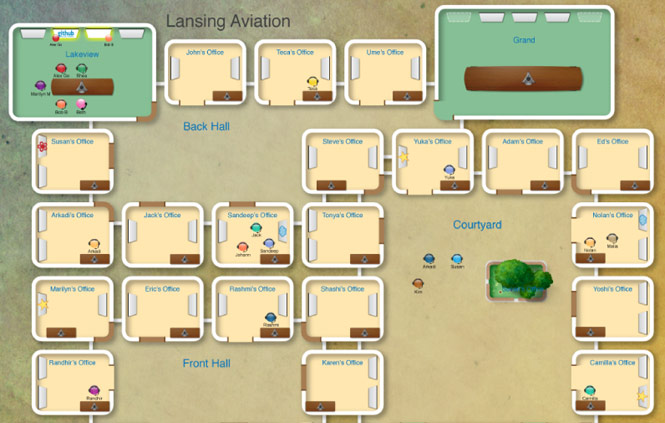
If you’re Sococo — short for social communication company — you create a virtual world, with virtual offices, desks, meeting rooms, and even buildings. But don’t think Second Life: You won’t find any sexy avatars, flying, pets, or islands. You will, however, see a lot of work getting done.
[aditude-amp id="flyingcarpet" targeting='{"env":"staging","page_type":"article","post_id":566674,"post_type":"story","post_chan":"none","tags":null,"ai":false,"category":"none","all_categories":"business,enterprise,mobile,social,","session":"C"}']“We bring distributed workers together to interact in real-time,” Sococo’s chief marketing officer Mark Fisher told me. “Coworkers talk, share, chat … and interact all day long.”
The service is built on a premise of connecting people in a more natural way. Spatial shifting is a key part of that — in a real office, you need to get out of your cube and walk to see someone else — but so is context and situational awareness.
AI Weekly
The must-read newsletter for AI and Big Data industry written by Khari Johnson, Kyle Wiggers, and Seth Colaner.
Included with VentureBeat Insider and VentureBeat VIP memberships.
“Today, if I phone you, I have no idea if you’re busy or not. And if I get your voicemail, I have no idea why … if you’re busy, or just don’t want to talk with me,” says Fisher. “Also, in all communication — instant messaging or similar — after it’s over, the session evaporates and there’s nothing to go back to.”
So Sococo not only provides a virtual space for interaction, it tells you if people are occupied and what they’re doing. For instance, when I jumped into the application, I could see Sococo’s CEO was in a conversation with someone in a room. The company calls it “social awareness,” and it helps you make decisions about who to talk to, who’s available, and when to connect.
In addition to the ability to share desktops, chat via voice or keyboard, add remote participants via a virtual phone, share applications for collaborative editing, and show presentations, and more, the company is adding multiple spaces today — separate office “buildings,” if you will. Companies can build multiple spaces to ensure that not only do teams have their own space, but they can connect to other teams, both inside and outside.
“There’s an important break point at 40 to 50 people,” Fisher told me. “We don’t want to just provide a long directory of everyone.”
The upshot of a virtual connected space?
[aditude-amp id="medium1" targeting='{"env":"staging","page_type":"article","post_id":566674,"post_type":"story","post_chan":"none","tags":null,"ai":false,"category":"none","all_categories":"business,enterprise,mobile,social,","session":"C"}']
“A person who works exclusively at their house feels connected to their team,” Fisher said. “That increases employee morale.”
Image credits: Sococo
VentureBeat's mission is to be a digital town square for technical decision-makers to gain knowledge about transformative enterprise technology and transact. Learn More